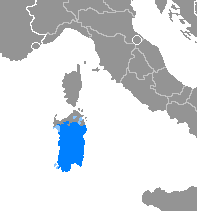
Sardinian or Sard is a Romance language spoken by the Sardinians on the Western Mediterranean island of Sardinia.
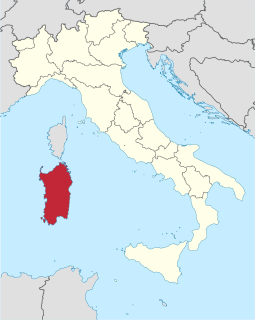
Sardinia is the second-largest island in the Mediterranean Sea, after Sicily, and one of the 20 regions of Italy. It is located west of the Italian Peninsula, north of Tunisia and immediately south of the French island of Corsica.

Carnival is a Western Christian festive season that occurs before the liturgical season of Lent. The main events typically occur during February or early March, during the period historically known as Shrovetide. Carnival typically involves public celebrations, including events such as parades, public street parties and other entertainments, combining some elements of a circus. Elaborate costumes and masks allow people to set aside their everyday individuality and experience a heightened sense of social unity. Participants often indulge in excessive consumption of alcohol, meat, and other foods that will be forgone during upcoming Lent. Traditionally, butter, milk, and other animal products were not consumed "excessively", rather, their stock was fully consumed as to reduce waste. This festival is known for being a time of great indulgence before Lent, with drinking, overeating, and various other activities of indulgence being performed. For example, Pancakes, donuts, and other desserts were prepared and eaten for a final time. During Lent, animal products are eaten less, and individuals have the ability to make a Lenten sacrifice, thus giving up a certain object or activity of desire.

Campidanese Sardinian is one of the two written standards of the Sardinian language, which is often considered one of the most, if not the most conservative of all the Romance languages. The orthography is based on the spoken dialects of central southern Sardinia, identified by certain attributes which are not found, or found to a lesser degree, among the Sardinian dialects centered on the other written form, Logudorese. Its ISO 639-3 code is sro.
Sardinia is probably the most culturally distinct of all the regions in Italy and, musically, is best known for the tenore polyphonic singing, sacred chants called gosos, the launeddas, an ancient instrument that consists of a set of three single-reed pipes, all three mouth-blown simultaneously using circular breathing, with two chanters and one drone and the cantu a chiterra, a monodic song that is accompanied by guitar, widespread mainly in the center and north of the island.

The Swabian-Alemannic Fastnacht, Fasnacht or Fasnat/Faschnat, is the pre-Lenten carnival in Alemannic folklore in Switzerland, southern Germany, Alsace and Vorarlberg.

Oliena is a commune in the province of Nuoro, Sardinia, Italy.
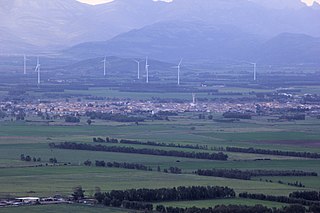
Pabillonis, Pabillonis in the Sardinian language, is a comune (municipality) in the Province of South Sardinia in the Italian region Sardinia, about 50 kilometres (31 mi) northwest of Cagliari and about 15 kilometres (9 mi) west of Sanluri.

Santu Lussurgiu is a comune (municipality) in the Province of Oristano in the Italian region Sardinia, located about 110 kilometres (68 mi) northwest of Cagliari and about 25 kilometres (16 mi) north of Oristano.
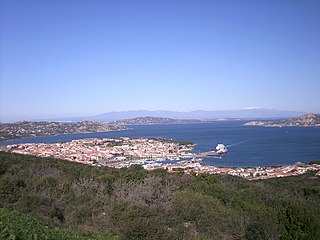
Palau is a comune (municipality) in the Province of Sassari in the Italian region Sardinia, about 220 kilometres (140 mi) north of Cagliari and about 30 kilometres (19 mi) northwest of Olbia. It was a frazione of the comune of Tempio Pausania until 1959.

The Carnival of Cádiz is one of the best-known carnivals in Spain. Its main characteristic is humor. Through sarcasm, mockery and irony, the main groups and the people of the street "purge" the most pressing problems of today. The whole city participates in the carnival for more than two weeks each year, and the presence of this fiesta is almost constant in the city because of the recitals and contests held throughout the year.
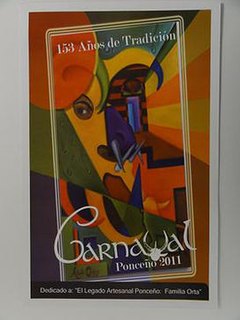
The Carnaval de Ponce, officially Carnaval Ponceño, is an annual celebration held in Ponce, Puerto Rico. The celebration lasts one week and it ends on the day before Ash Wednesday. Thus, it is generally held in February and sometimes in March. It is one of the oldest carnivals of the Western Hemisphere, dating back to 1858. Some authorities, such as the Smithsonian Institution, believe the Ponce Carnaval can be traced to as far back as 250 years ago. The Carnaval coincides with the Mardi Gras of New Orleans, the Carnival of Venice, and Rio de Janeiro's Carnival. The estimated attendance is 100,000. Scenes of the 2011 Carnaval Ponceño were featured in the Travel Channel on 7 August 2011.
The cuisine of Sardinia is the traditional cuisine of the island of Sardinia, and the expression of its culinary art. It is characterised by its own variety, and by the fact of having been enriched through a number of interactions with the other Mediterranean cultures while retaining its own identity. Sardinia's food culture is strictly divided into food from the land and food from the sea, reflecting the island's historical vicissitudes and especially its geographic landscapes, spacing from the coastline to the ragged mountains of the interior. The Sardinian cuisine is considered part of the Mediterranean diet, a nutritional model that was proclaimed by UNESCO as an intangible cultural heritage.

The Solo Batik Carnival or SBC is an annual carnival held in Solo City, Indonesia. The word "carnival" here is not related with the Christian pre-Lent celebration, but more of a festivities in general, with procession of dancers in extravagant costumes, with emphasis on the Indonesian motif of batik.

The Nuragic civilization, also known as the Nuragic culture was a civilization or culture on the second largest island in the Mediterranean Sea, Sardinia (Italy), which lasted from the 18th century BCE up to the Roman colonization in 238 BCE. Others date the culture as lasting at least until the 2nd century AD or possibly even to the 6th century AD.

The Sardinians, or Sards, are a Romance language-speaking ethnic group native to Sardinia, from which the western Mediterranean island and autonomous region of Italy derives its name.
The most famous carnivals of Italy are those held in Venice, Viareggio, Ivrea, Cento, Gambettola, Satriano, and Acireale. These carnivals include sophisticate masquerades and parades. A completely different form or Carnival takes place in Sardinia, based on rituals to awaken the earth after Winter, possibly descending from pre-Christian traditions.
The Carnival in the Dominican Republic is a Dominican celebration that takes place throughout February; although some Dominicans (rarely) celebrate it during Holy Week in March. Dominicans are usually most festive on February 27th, which is the Dominican Independence Day. In Santo Domingo, celebrations include a large military display with the Dominican air force, navy, and army. Festivities often include the wearing of colorful costumes that symbolize Dominican religious and traditional characters such as Calife, Guloya, and Diablo Cojuelo. Festivities take place all over the island, with each town adding its own twist to the celebration.
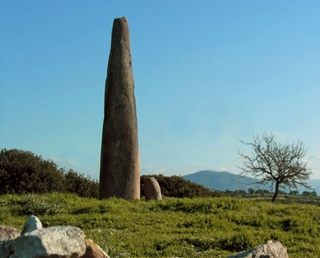
The Pre-Nuragic period refers to the prehistory of Sardinia from the Paleolithic till the middle Bronze Age, when the Nuragic civilization flourished on the island.
The Ilienses were an ancient Nuragic people who lived during the Bronze and Iron Ages in central-southern Sardinia, as well as one of the three major groups among which the ancient Sardinians considered themselves divided. After the Sicilian Wars began with the Punic invasion in the sixth century BC, part of them retreated to the mountainous interior of the island, from which they opposed for centuries the foreign rule.





























